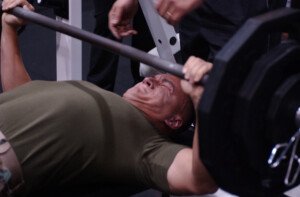
If a diabetic had to choose one form of exercise for weight loss, either strength training or cardio, one of these is much better for igniting fat loss.
Obesity and even a moderate amount of excess body fat are risk factors for developing type 2 diabetes.
Type 2 Diabetes
• Pancreas produces insulin.
• Insulin transport system for glucose to muscle cells is impaired.
• Impairment may include a shortage of insulin receptor sites on muscle cells.
Weight Loss Should = Fat Loss
You don’t want to get “skinny fat,” and thus, the overweight diabetic (as anyone else) should strive to not just lose excess fat but gain lean muscle tissue.
“Weight loss with diabetes is a tricky thing, so you should keep a couple things in mind,” begins Sheri Colberg, PhD, Professor Emerita, Exercise Science, Old Dominion University, founder of Diabetes Motion, and one of the world’s leading experts on diabetes and exercise.
“#1. Dieting alone may help you lose weight faster, but you lose a lot more of your lean body mass [muscle] if you’re not exercising when cutting back on calories,” contines Dr. Colberg. “You need to exercise, and either strength training or cardio work will help you lose body fat.”
“#2. Fat loss should be your goal, not just weight loss.”
Strength Training vs. Cardio for Weight Loss in Diabetics
When people want to lose weight, they typically call it “weight loss” rather than “fat loss.”
A bathroom scale measures total body weight loss, not how many of those lost pounds are actually fat.
You may see zero pounds lost on the scale, but may have lost five pounds of fat and gained five pounds of valuable lean muscle.
If the diabetic had to choose between the same time spent strength training vs. cardio to lose fat, the winner hands down is strength training – assuming that the strength training focuses on compound movements at an intense level, when compared to fixed-pace cardio such as brisk neighborhood walks or a steady state pedaling on the elliptical machine.

For example, two intense weight training days a week for one hour each will burn off more fat than will two, one-hour sessions of steady state cardio.
Steady state cardio alone, with proper diet, WILL cause some fat loss, but not nearly as much as the same amount of time spent each week lifting weights.
Strength Training Beats Cardio at Weight Loss for Diabetics When…
• The body’s biggest muscles get most of the weight training workout. Big muscles like those in the legs and back require more energy than do small muscles like the biceps and abdominals.
• You focus on compound moves like the deadlift (below), some form of squat, seated row, lat pull-down, kettlebell swing, leg press, bench press and overhead press.

Freepik.com
• Most sets are intense, meaning, you must struggle to complete between eight and 12 repetitions.
Struggling incites fat loss. Merely completing this number range yet feeling like you can go to 15, let alone 18, reps, will not burn as much fat.
• Rests between these intense sets are 60 to 75 seconds.
• You apply progressive resistance. This means aiming to move more weight as time goes on rather than being stuck for six months at an 85 pound deadlift.
“I almost always tell people that if they have to choose to add only one activity into their lives, it should be resistance training,” says Dr. Colberg.
“I say that, though, for reasons of health and vitality since older adults are losing muscle mass and need it to live independently.
“Muscle mass is also where we store the carbs we eat as glycogen, and you need your carb ‘muscle tank’ to be as big as possible and partway empty (so more can go in).
“People become very insulin resistant when their muscle glycogen stores are full (from inactivity and/or overeating).”
But not all type 2 diabetics are over 50. In America, more and more type 2 diabetes diagnoses are being made in younger people, including teenagers and children!
If a young person doesn’t regularly do weight-bearing exercise, diabetic or not, they will begin losing precious muscle mass at around age 30, to the tune of five pounds of muscle lost per decade.
Gaining lean muscle is important for even young adult diabetics, because muscle is the body’s metabolic furnace.
The more lean mass you have, the faster will be your resting metabolism.
“The research does show that either type of exercise [strength training or cardio] helps people lose the ‘bad’ fat stored inside their abdomen (visceral fat), whereas dieting alone won’t necessarily help you lose this type of fat,” says Dr. Colberg.
“Visceral fat is closely associated with insulin resistance, heart disease, hypertension and all of the metabolic diseases.
“You have to exercise to effectively get rid of visceral fat that interferes with normal metabolism.”
Many people who want to lose weight—and diabetics are no exception—will not strength train as per the aforementioned guidelines.
As a former personal trainer, I had many clients who required my continuous “Come on, you can do it! Push!” in order to crank out intense sets. If left alone, they’d merely go through the motions with lighter resistance.
This is why many people who train with weights don’t see startling fat loss or the so-called body transformations over a six month period.
So with that all said, here is what Dr. Colberg exlains: “For weight loss, either type of activity uses up calories and results in greater loss of just fat (and retention of muscle mass).
“It’s always good to have more muscle mass for various reasons, though, and it is best gained through resistance training — but it does make weight loss on the scale much slower when you’re gaining muscle while losing fat.”
A skin-fold test with calipers, done by a personal trainer, can record change in body composition over time.
But if you don’t have access to this tool, Dr. Colberg recommends a clothes test rather than the scale.
“Pick a snug pair of pants (not stretchy one) and use those as your guide. When your pants are looser, you’re losing fat that your bathroom scale may not reflect as quickly since you’re keeping your muscle mass by exercising.”
Final Thoughts
Whether you’re diabetic or not, don’t choose between strength training and cardio. DO BOTH! Just don’t do them on the same days.

Shutterstock/gpointstudio
Weight training, by the way, increases the number of insulin receptor sites on your muscle cells: always a good deal for the diabetic.
You may also want to try a cardio training technique called high intensity interval training.
Unlike steady state cardio, HIIT (like intense strength training) causes your resting metabolism to be elevated for several hours after the workout.
This is great for the diabetic who’s ready to lose unwanted body fat.
 The mission of Diabetes Motion is to provide practical guidance about blood glucose management to active diabetics. Dr. Sheri Colberg is the author of “Diabetes & Keeping Fit for Dummies.”
The mission of Diabetes Motion is to provide practical guidance about blood glucose management to active diabetics. Dr. Sheri Colberg is the author of “Diabetes & Keeping Fit for Dummies.”
 Lorra Garrick has been covering medical, fitness and cybersecurity topics for many years, having written thousands of articles for print magazines and websites, including as a ghostwriter. She’s also a former ACE-certified personal trainer.
Lorra Garrick has been covering medical, fitness and cybersecurity topics for many years, having written thousands of articles for print magazines and websites, including as a ghostwriter. She’s also a former ACE-certified personal trainer.
.

























